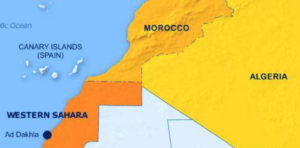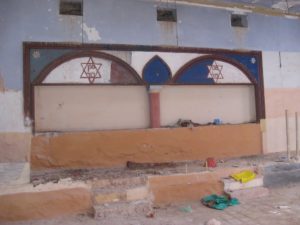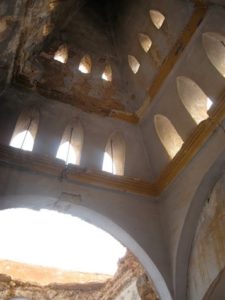 In 1921, 1,400 Jews lived at Ghardaia, in 1931 – 1,300, and in 1955 – 1,250. When Jews arrived in Ghardaia they began building a city that contained a Mellah (Jewish Quarter). The Mellah had very narrow streets, and only two were barely wide enough to allow a cart or a car to pass. It also had tunnels.
In 1921, 1,400 Jews lived at Ghardaia, in 1931 – 1,300, and in 1955 – 1,250. When Jews arrived in Ghardaia they began building a city that contained a Mellah (Jewish Quarter). The Mellah had very narrow streets, and only two were barely wide enough to allow a cart or a car to pass. It also had tunnels.
The central synagogue of the community stood at the end of a narrow stairs alley, which was reached through a covered street.
The building had a dome supported on columns and was linked to the other buildings around it. It was built at the beginning of the 20th century following the destruction of the older building by fire. It was spacious, airy, and well lighted by a high pyramidal cupola.
 The old synagogue had been smaller, built of a mixture of pebbles and chalk stones. At Ghardaia there was a Talmud Torah for children, where Hebrew and Torah were taught.
The old synagogue had been smaller, built of a mixture of pebbles and chalk stones. At Ghardaia there was a Talmud Torah for children, where Hebrew and Torah were taught.
The important families of the community at that time were Elbaz, Atiya, Partosh, Baluka and Sulam. In the 1950’s Abraham Elbaz was the community’s rabbi. Members of the poorer families worked as clerks for the Jewish rich merchants. The tax collectors of Ghardaia were all Jewish.
During 1943-1950, because of local tensions, the Jews began to leave and 500-600 of them emigrated to Israel. Some also went to France.
 When Algeria’s war of independence broke out and a hand grenade was thrown in a place where Jews congregated it encouraged emigration. In 1961-2 Makhluf Partosh and other Jewish families decided to leave because of the spreading violence. Within a short time all the Jews of Ghardaia left.
When Algeria’s war of independence broke out and a hand grenade was thrown in a place where Jews congregated it encouraged emigration. In 1961-2 Makhluf Partosh and other Jewish families decided to leave because of the spreading violence. Within a short time all the Jews of Ghardaia left.
Jews were also found in the Berber “ksurs” (fortified villages) all along southern Morocco and in the adjacent Sahara. Thus, at Outat near Tafilalt there is a mellah with about 500 Jews; and at Figuig, a mellah with 100 Jews.
Going farther south to Tuat, there is a large community of Jews in the oasis of Alhamada; and at Tamentit, a two weeks’ journey from Tafilalt, the 6,000 or 8,000 inhabitants are said to be descendants of Jews converted to Islam. Even much farther to the west, in the province of Sus, there is Ogulmin with 3,000 inhabitants, of whom 100 are said to be Jews.